
Review By Richard Kirkham
[ This essay was originally Published on the deleted site "Fogs Movie Reviews" in the Fall of 2013]
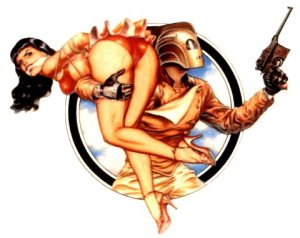 Hollywood
in the Golden Age, Nazi Commandos, Gangsters, Young Love, Air Speed
Races, Howard Hughes, is there anything that is not found in this Walt
Disney Picture from more than twenty years ago? I can't think of
anything they could have added to make this movie better. The story is a
clever adventure which mixes real world events with science fiction
elements and puts it in the backdrop of one of the most romantic times
and places in film history. "The Rocketeer" was a modest success and not
a break out hit that would justify a sequel. The movie harkens back to
the serial adventures of the 1940s but is based on a racy 1982 graphic
novel/comic, which has enjoyed greater literary success than it's
cinematic cousin. There are some obvious changes made in adapting this
to the big screen. The biggest change was altering the character of
Jenny Blake. Instead of the somewhat seedy "party girl/stripper" she is
in the comic, she becomes a more wholesome ingenue. She is an innocent
young actress, trying to break into the movies by playing in the crowd
scenes in the movies being manufactured at the Hollywood Dream Factories
of the Golden Age.
Hollywood
in the Golden Age, Nazi Commandos, Gangsters, Young Love, Air Speed
Races, Howard Hughes, is there anything that is not found in this Walt
Disney Picture from more than twenty years ago? I can't think of
anything they could have added to make this movie better. The story is a
clever adventure which mixes real world events with science fiction
elements and puts it in the backdrop of one of the most romantic times
and places in film history. "The Rocketeer" was a modest success and not
a break out hit that would justify a sequel. The movie harkens back to
the serial adventures of the 1940s but is based on a racy 1982 graphic
novel/comic, which has enjoyed greater literary success than it's
cinematic cousin. There are some obvious changes made in adapting this
to the big screen. The biggest change was altering the character of
Jenny Blake. Instead of the somewhat seedy "party girl/stripper" she is
in the comic, she becomes a more wholesome ingenue. She is an innocent
young actress, trying to break into the movies by playing in the crowd
scenes in the movies being manufactured at the Hollywood Dream Factories
of the Golden Age.
 Jenny's
boyfriend is Cliff Secord, a barnstorming pilot trying to get his new
plane ready for the national air races. Southern California was in a
growth spurt when it comes to aviation. By 1939 more than half the
planes in the country were made in the state. Aviation was a glamorous
venture, which made heroes of Charles Lindbergh, Amelia Earhart and
Howard Hughes. The Smithsonian Air and Space Museum has an extensive
collection of the "buzz bomb" type planes used by the racers of the
time.
This was the golden age of aviation and it crosses paths in our story
with the golden age of Hollywood. Cliff and his mechanic mentor Peevy
discover a rocket pack, hidden in their old bi-plane by gangsters trying
to escape from the FBI. The crooks substitute an old vacuum cleaner for
the rocket and when their car explodes, destroying Cliff's racing
plane, the feds believe the rocket was destroyed as well. So Cliff and
Peevy look to the Rocket as a way of making back some money to restore
their dreams of racing in the Nationals.
It turns out that the gangsters are seeking the rocket pack for a
Hollywood star. In 1980, celebrity biographer Charles Higham published a
book that claimed that Errol Flynn, the swashbuckling star of "the
Adventures of Robin Hood" was a Nazi spy. The book was widely criticized
by scholars and reviewers for the slipshod reasoning that Higham used
to reach his conclusions. In fact, Flynn's family sued, but since Flynn
had died in 1959, the courts tossed the case on the legal premise that
the dead can't be libeled. Flash forward ten years and the slander is
now being used in a slightly disguised manner. The film Jenny is working
on stars Neville Sinclair, a character clearly based on Errol Flynn.
The confluence of events and setting creates a truly entertaining story,
that anyone who loves movies should appreciate.
Jenny's
boyfriend is Cliff Secord, a barnstorming pilot trying to get his new
plane ready for the national air races. Southern California was in a
growth spurt when it comes to aviation. By 1939 more than half the
planes in the country were made in the state. Aviation was a glamorous
venture, which made heroes of Charles Lindbergh, Amelia Earhart and
Howard Hughes. The Smithsonian Air and Space Museum has an extensive
collection of the "buzz bomb" type planes used by the racers of the
time.
This was the golden age of aviation and it crosses paths in our story
with the golden age of Hollywood. Cliff and his mechanic mentor Peevy
discover a rocket pack, hidden in their old bi-plane by gangsters trying
to escape from the FBI. The crooks substitute an old vacuum cleaner for
the rocket and when their car explodes, destroying Cliff's racing
plane, the feds believe the rocket was destroyed as well. So Cliff and
Peevy look to the Rocket as a way of making back some money to restore
their dreams of racing in the Nationals.
It turns out that the gangsters are seeking the rocket pack for a
Hollywood star. In 1980, celebrity biographer Charles Higham published a
book that claimed that Errol Flynn, the swashbuckling star of "the
Adventures of Robin Hood" was a Nazi spy. The book was widely criticized
by scholars and reviewers for the slipshod reasoning that Higham used
to reach his conclusions. In fact, Flynn's family sued, but since Flynn
had died in 1959, the courts tossed the case on the legal premise that
the dead can't be libeled. Flash forward ten years and the slander is
now being used in a slightly disguised manner. The film Jenny is working
on stars Neville Sinclair, a character clearly based on Errol Flynn.
The confluence of events and setting creates a truly entertaining story,
that anyone who loves movies should appreciate.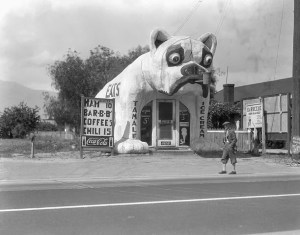 The look of the
film is outstanding. The airfield out in the valley is stocked with old
bi-wings and hopped up racing planes. The wooden bleachers used at the
airshow and the hanger where many early events take place give a genuine
feel for the aviation industry of the period. Not too far from the
airfield is a diner that caters to the pilots and mechanics. It is
modeled after a real food joint here in Los Angeles at the time.
The interior is a lot more spacious than the exterior would allow, so a
little movie magic has to be forgiven. One of the nice touches in the
set is the wall near the telephone where at one point the bad guys
discover the phone number for Jenny, the girl they are at that point
trying to track down.
The look of the
film is outstanding. The airfield out in the valley is stocked with old
bi-wings and hopped up racing planes. The wooden bleachers used at the
airshow and the hanger where many early events take place give a genuine
feel for the aviation industry of the period. Not too far from the
airfield is a diner that caters to the pilots and mechanics. It is
modeled after a real food joint here in Los Angeles at the time.
The interior is a lot more spacious than the exterior would allow, so a
little movie magic has to be forgiven. One of the nice touches in the
set is the wall near the telephone where at one point the bad guys
discover the phone number for Jenny, the girl they are at that point
trying to track down. 
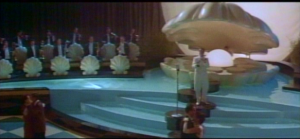 There are dozens of little touches like this that make the film feel
incredibly authentic. In the Hollywood sequences, there is a large set
for "The South Seas Club", an upscale nightclub and restaurant, run by
Eddie Valentine, the mobster being employed by Sinclair to obtain the
rocket. The Front of the club is clearly on a backlot street but the
interior looks luxurious and ethereal. The big band singer makes her
appearance rising out of a giant clam shell. The tables, booths and
dance floors remind us of a hundred art deco sets from 1930s era films.
Only here the lighting is colored in dramatic flourishes of green and
blue.
When Neville leaves Jenny at their table to go and speak to Eddie in
his office, you can see a mermaid swimming in a large fish tank behind
him. As Cliff sneaks into the club, he hides in the laundry room,
labeled with a nice deco font on the sign. Everywhere, there is
attention to the kinds of details that might be ignored in a lesser
production.
There are dozens of little touches like this that make the film feel
incredibly authentic. In the Hollywood sequences, there is a large set
for "The South Seas Club", an upscale nightclub and restaurant, run by
Eddie Valentine, the mobster being employed by Sinclair to obtain the
rocket. The Front of the club is clearly on a backlot street but the
interior looks luxurious and ethereal. The big band singer makes her
appearance rising out of a giant clam shell. The tables, booths and
dance floors remind us of a hundred art deco sets from 1930s era films.
Only here the lighting is colored in dramatic flourishes of green and
blue.
When Neville leaves Jenny at their table to go and speak to Eddie in
his office, you can see a mermaid swimming in a large fish tank behind
him. As Cliff sneaks into the club, he hides in the laundry room,
labeled with a nice deco font on the sign. Everywhere, there is
attention to the kinds of details that might be ignored in a lesser
production.Howard Hughes and the FBI ultimately track down Cliff, and reveal to him the importance of the rocket pack. There is a brilliant one minute propaganda piece done in simple animation that conveys the breadth of the danger that "The Rocketeer" must prevent.
Suddenly, the story takes on broader implications and you can see why Cliff has to try to save Jenny, because otherwise she could be sacrificed in the interests of a bigger world. The Hughes scenes are some of the best in the film because they feature the actor Terry O'Quinn who has been making everything he appears in better for the last thirty three years. The famous "Spruce Goose" plane that had been part of a wartime project mired in controversy, makes an advance appearance here in model form. There is a fun little escape bit that features the plane and O'Quinn has a line that foretells some of the later controversy. Since I have mentioned one of the supporting players, it would be a little unfair to ignore the other actors that help bring this piece of romantic pulp to life. Alan Arkin was playing old way back in 1991, his character Peevy is the wizened mentor to our hero. His line delivery and general demeanor are solid as always but he adds a twinkle in the eye whenever the aviation mechanics get discussed, making his character a lot more interesting than he would otherwise have been. John Polito, a ubiquitous presence on TV and in movies plays Bigelow, the smarmy manager of the airfield and show that Cliff moonlights for. The sight gag concerning his character's resolution is funny but a bit disturbing. An actor I have always appreciated, despite the fact that he never had a role that allowed him to be front and center is Ed Lauter. He plays FBI agent Fitch with a sneer that he could trademark. When the tommy guns come out on a couple of occasions, you can see the glee in his eye as the tough guy gets to do what he does best.
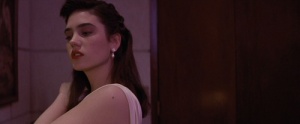 The three
leads of the picture are cast perfectly. The luminous Jennifer Connelly
is Jenny Blake, and she sparkles as the damsel in distress. She is a
love interest that would clearly make both men stop and take notice. Her
character is also a lot more engaged in the plot than simply being the
object of rescue. She links the characters together and her soft line
delivery keeps the character from becoming shrill like others in similar
roles have become. The scenes where she engages in a uncertain
seduction sequence with Neville Sinclar after being drugged by him are
incredibly sexy without being vulgar.
The switch in character might be off putting to fans of the comics, but
it made the love angle much more effective in the movie. While we might
have enjoyed seeing her as a Bettie Page stand in, her character is
more interesting with the change and it helps broaden the appeal of the
movie. Billy Campbell was a stalwart hero type, with an eager manner and
a handsome face. He brought a certain naivete to the part of Cliff
Secord. The pilot is so caught up in the aviation issues that he doesn't
always see how important his girl is to him. When he sees the
propaganda film, it is like he awakens from a being a frivolous
adventurer to becoming a hero. He had of course done heroic things
earlier in the movie, but usually without much thought. His decision to
escape the FBI and go after the Nazi spy ring himself is based in part
on Jenny but also on the seriousness of the threat. When he evaded the
gangsters at the South Seas Club, it is almost comic..
The three
leads of the picture are cast perfectly. The luminous Jennifer Connelly
is Jenny Blake, and she sparkles as the damsel in distress. She is a
love interest that would clearly make both men stop and take notice. Her
character is also a lot more engaged in the plot than simply being the
object of rescue. She links the characters together and her soft line
delivery keeps the character from becoming shrill like others in similar
roles have become. The scenes where she engages in a uncertain
seduction sequence with Neville Sinclar after being drugged by him are
incredibly sexy without being vulgar.
The switch in character might be off putting to fans of the comics, but
it made the love angle much more effective in the movie. While we might
have enjoyed seeing her as a Bettie Page stand in, her character is
more interesting with the change and it helps broaden the appeal of the
movie. Billy Campbell was a stalwart hero type, with an eager manner and
a handsome face. He brought a certain naivete to the part of Cliff
Secord. The pilot is so caught up in the aviation issues that he doesn't
always see how important his girl is to him. When he sees the
propaganda film, it is like he awakens from a being a frivolous
adventurer to becoming a hero. He had of course done heroic things
earlier in the movie, but usually without much thought. His decision to
escape the FBI and go after the Nazi spy ring himself is based in part
on Jenny but also on the seriousness of the threat. When he evaded the
gangsters at the South Seas Club, it is almost comic..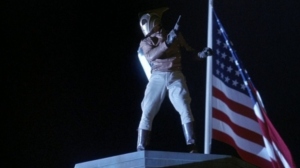 When he escapes the clutches of the Nazi's, he grabs a gun, something
he had not done before. The shot of him on top of the Griffith
Observatory, with the flag waving behind him as he launched toward the
airship, is the moment he is branded "HEROIC".
When he escapes the clutches of the Nazi's, he grabs a gun, something
he had not done before. The shot of him on top of the Griffith
Observatory, with the flag waving behind him as he launched toward the
airship, is the moment he is branded "HEROIC".The final piece of the puzzle is the great Timothy Dalton. Denied an opportunity to continue as James Bond, this was his next major project and it is a solid indicator of the quality actor that the Bond franchise lost. Dalton plays Sinclair as hero, villain, clown and threat. He is oily smoothness when he tries to seduce Jenny in an attempt to locate the rocket. He plays the "star" on the movie set, both as a real actor and as a Prima donna. When he banters with Paul Sorvino playing gangster Eddie Valentine, you can detect the disdain this big movie star, secret agent feels for having to consort with hoods. When he responds to Jenny's accusation near the end of the film that "everything about you is a lie", you can hear the ego come out in his retort "It wasn't lies Jenny, it was acting."
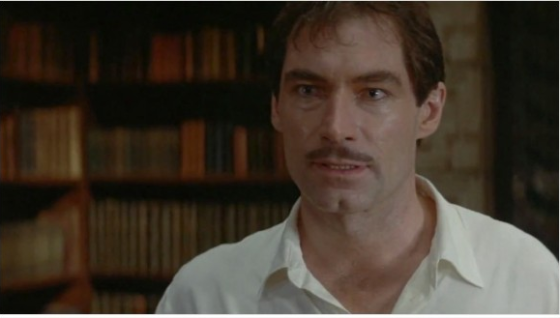
"The Rocketeer" is rousing piece of nostalgia. It combines Hollywood and aviation at the height of their romantic periods and presents us with a credible love story to boot. The mixture of real characters with fictional representations of real characters and finally fictional characters, works to build a fun and exciting adventure story. Even if you can't get behind the story however, there is amazing production design that will evoke the era in a thousand ways. The director Joe Johnson revisits this territory in the recent Marvel Super Hero flick, Captain America: The First Avenger. Johnson has the right touch for this time period. The nightclub sequences and the stunt show all reflect careful planning. Just as an illustration of the love Johnson seems to have for the period, listen to the big band singer. She performs for a longer period than needed to set the tone and her arrival is special despite the fact that she is merely scenery. Listen to the James Horner score and see how it is used to set the tone so frequently. The dialogue is filled with 30's slang and aviation jargon and the gangsters look like the crooks in the movies, even if real crooks don't look like that. This is a great family film and I can't imagine that anyone out there with kids over the age of eight, wouldn't be thrilled to share this inventive big screen adventure with them. Don't be surprised if they start running around with pots on their heads instead of cape. This movie can inspire that kind of childhood imagination.
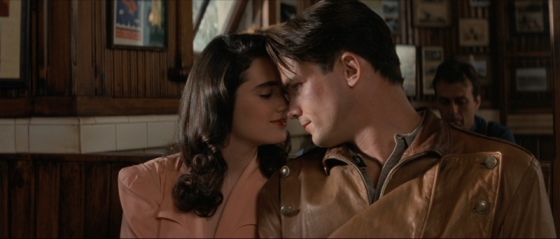
Richard Kirkham is a lifelong movie enthusiast from Southern California. While embracing all genres of film making, he is especially moved to write about and share his memories of movies from his formative years, the glorious 1970s. His personal blog, featuring current film reviews as well as his Summers of the 1970s movie project, can be found at Kirkham A Movie A Day.
No comments:
Post a Comment